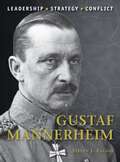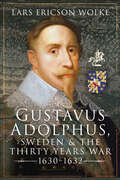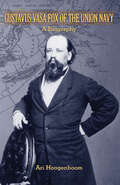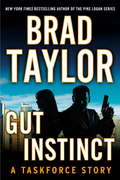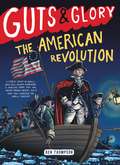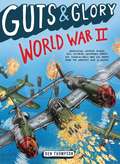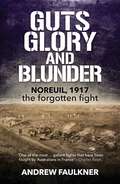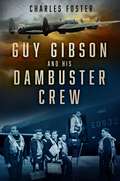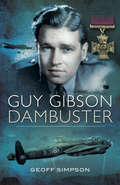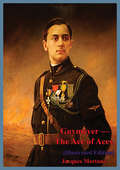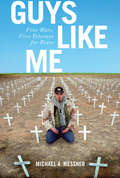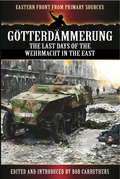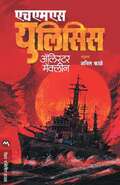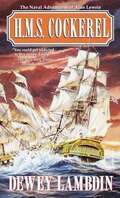- Table View
- List View
Gustaf Mannerheim
by Steven J. ZalogaCarl Gustaf Emil Mannerheim is a legendary figure, whose life and career were deeply influential in Finnish and European history. He is viewed by many as the father of modern Finland after leading the 'White' faction to victory and independence in the Finnish Civil War of 1918. That conflict preceded a sequence of bitter clashes between Finland, Soviet Russia and Nazi Germany in the buildup to, and during, World War II: The Winter War in 1940, the Continuation War and the Lapland War in 1944-45. Throughout these fierce clashes in the ice and snow, Mannerheim managed his forces with great skill, even though the initiative was to swing back and forth between the adversaries. This study provides a fascinating insight into Mannerheim's career, analysing his traits, his biggest victories and his key enemies. Complete with uniform artwork and detailed tactical maps, it is a comprehensive guide to one of history's most capable military leaders and statesmen.
Gustavus Adolphus, Sweden and the Thirty Years War, 1630–1632
by Lars Ericson WolkeThe little-known story of the Swedish king and military commander who conquered much of Germany in the early seventeenth century. As one of the foremost military commanders of the early seventeenth century, Gustavus Adophus, king of Sweden, played a vital role in defending the Protestant cause during the Thirty Years War. In the space of two years—between 1630 and 1632—he turned the course of the war, winning a decisive victory at the Battle of Breitenfeld and conquering large parts of Germany. Yet remarkably little has been written about him in English, and no full account of his extraordinary career has been published in recent times. That is why this perceptive and scholarly study is of such value. The book sets Gustavus in the context of Swedish and European dynastic politics and religious conflict in the early seventeenth century, and describes in detail Swedish military organization and Gustavus&’s reforms. His intervention in the Thirty Years War is covered in graphic detail—the decision to intervene, his alliance with France, his campaigns across the breadth of Germany, and his generalship at the two major battles he fought there. His exceptional skill as a battlefield commander transformed the fortunes of the Protestant side in the conflict, and he had established himself as a major European figure before his death on the battlefield. Lars Ericson Wolke, one of the leading experts on the military history of the Baltic and the Thirty Years War, offers a fascinating insight into Gustavus the man and the soldier.
Gustavus Vasa Fox of the Union Navy: A Biography
by Ari HoogenboomThis magisterial biography recounts the life and career of one of the U.S. Navy’s most influential officers, Gustavus Vasa Fox. Ari Hoogenboom's examination of Fox's incredible life and distinguished career creates a vivid portrait of the man most responsible for the U.S. Navy's stellar performance in the Civil War. Fox’s naval service began in 1838 when he went to sea as a midshipman. He sailed in the Mediterranean, off the coast of Africa, in the Gulf of Mexico, and with the East India Squadron in the Pacific. By participating in the Coast Survey and by navigating the lower Mississippi River in the 1850s, as captain of a steamer that ran from New York to Havana to New Orleans and back, Fox gained valuable experience that would serve him well in the Civil War.During the war, Fox was instrumental in mounting the blockade of the southern coast, from the Chesapeake Bay to the Rio Grande. After the battle between the Monitor and the Virginia, Fox championed ironclad technology despite having to contend with an officer corps wedded to wooden ships. In planning and coordinating expeditions, Fox deserves much of the credit for the navy's successes at Hatteras, Port Royal, New Orleans, Mobile Bay, and Fort Fisher.Initially neither proslavery nor antislavery, Fox was passionately committed to the preservation of the Union and, as black sailors made a crucial contribution toward that end, became an advocate of freedom and voting rights for African Americans. A skilled administrator who understood both the demands of politicians and the needs of line officers, he was able to communicate effectively with each group. Fox developed a close and collegial working relationship with Abraham Lincoln and was related by marriage to the postmaster general. Along with officers like Quartermaster General Montgomery Meigs and coordinator of military railroads Herman Haupt, Fox played a critical but underappreciated role in the Union victory.
Gustavus Vasa Fox of the Union Navy: A Biography
by Ari HoogenboomThis “fine, perhaps definitive, biography” of the man who guided the U.S. Navy’s stellar Civil War campaigns “should be on every naval bookshelf” (Washington Times).Gustavus Vasa Fox began his naval service in 1838, when he went to sea as a midshipman. He sailed in the Mediterranean, off the coast of Africa, in the Gulf of Mexico, and with the East India Squadron in the Pacific. His experiences working on the Coast Survey, navigating the lower Mississippi River, and captaining a steamer that ran from New York to Havana to New Orleans and back, would all prove invaluable in the Civil War.During the war, Fox was instrumental in mounting the blockade of the southern coast, from the Chesapeake Bay to the Rio Grande. In planning and coordinating expeditions, Fox deserves much of the credit for the navy’s successes at Hatteras, Port Royal, New Orleans, Mobile Bay, and Fort Fisher.Passionately committed to preserving the Union, Fox also became an advocate of freedom and voting rights for African Americans. He was a skilled administrator who understood politics and developed a close working relationship with Abraham Lincoln. Along with officers like Quartermaster General Montgomery Meigs and coordinator of military railroads Herman Haupt, Fox played a critical but overlooked role in the Union victory.
Gut Instinct
by Brad TaylorRetired Delta Force officer Brad Taylor delivers an action-packed short story that sets Pike Logan's partner Jennifer Cahill against a fellow Taskforce operator in a mission that will put their authority, careers, and innocent lives on the line. Includes an exclusive preview of Brad Taylor's hotly anticipated fourth Pike Logan novel, The Widow's Strike, coming July 16, 2013. Fresh off of a brutal mission with the Taskforce--a top secret counter-terrorist unit that operates outside the bounds of U.S. law--Pike Logan and Jennifer Cahill are still dealing with its aftereffects. With his injuries on the mend, Pike is forced to let Jennifer take the lead when another Taskforce team asks for her help. But when her stint spying on two women suspected of involvement in a terrorist plot leads her in another direction, the team leader won't take her seriously. Butting heads with him costs them credibility, but Jennifer won't let it go. Determined to uncover the true target, Pike must trust Jennifer's instincts more than ever. Being wrong means risking their reputations and future with the Taskforce, but being right means averting a threat that nobody else can see. A threat that may be bigger than they can handle.
Gut Instinct
by Brad TaylorRetired Delta Force officer Brad Taylor delivers an action-packed short story that sets Pike Logan's partner Jennifer Cahill against a fellow Taskforce operator in a mission that will put their authority, careers, and innocent lives on the line.Includes an exclusive preview of Brad Taylor's hotly anticipated fourth Pike Logan novel, The Widow's Strike, coming July 16, 2013. Fresh off of a brutal mission with the Taskforce--a top secret counter-terrorist unit that operates outside the bounds of U.S. law--Pike Logan and Jennifer Cahill are still dealing with its aftereffects. With his injuries on the mend, Pike is forced to let Jennifer take the lead when another Taskforce team asks for her help. But when her stint spying on two women suspected of involvement in a terrorist plot leads her in another direction, the team leader won't take her seriously. Butting heads with him costs them credibility, but Jennifer won't let it go. Determined to uncover the true target, Pike must trust Jennifer's instincts more than ever. Being wrong means risking their reputations and future with the Taskforce, but being right means averting a threat that nobody else can see. A threat that may be bigger than they can handle.
Gut Instinct: A Taskforce Story, Featuring an Excerpt from The Forgotten Soldier
by Brad TaylorRetired Delta Force officer Brad Taylor delivers an action-packed short story that sets Pike Logan's partner Jennifer Cahill against a fellow Taskforce operator in a mission that will put their authority, careers, and innocent lives on the line.Includes an excerpt of Brad Taylor's latest Pike Logan novel, The Forgotten Soldier, on sale 12/29/2015. Fresh off of a brutal mission with the Taskforce--a top secret counter-terrorist unit that operates outside the bounds of U.S. law--Pike Logan and Jennifer Cahill are still dealing with its aftereffects. With his injuries on the mend, Pike is forced to let Jennifer take the lead when another Taskforce team asks for her help. But when her stint spying on two women suspected of involvement in a terrorist plot leads her in another direction, the team leader won't take her seriously. Butting heads with him costs them credibility, but Jennifer won't let it go. Determined to uncover the true target, Pike must trust Jennifer's instincts more than ever. Being wrong means risking their reputations and future with the Taskforce, but being right means averting a threat that nobody else can see. A threat that may be bigger than they can handle.
Guthrie's War: A Surgeon of the Peninsula & Waterloo
by Michael CrumplinThe precepts laid down are the result of the experience acquired in the war in the Peninsula, from the first battle of Rolia in 1808, to the last in Belgium, of Waterloo in 1815They have been the means of saving the lives, and of relieving, if not even of preventing, the miseries of thousands of our fellow-creatures throughout the civilized world.George James Guthrie is one of the unsung heroes of the Peninsular War and Waterloo, and of British military medicine. He was a guiding light in surgery. He was not only a soldier's surgeon and a hands-on doctor, he also set a precedent by keeping records and statistics of cases. While the innovations in the medical services of the French Republic and Empire have been publicized, a military surgeon of the caliber of Guthrie has been largely ignored by students of the period until now. Michael Crumplin, in this comprehensive and graphic study of this remarkable doctor, follows him through his career in the field and recognizes his exceptional contribution to British military medicine and to Wellington's army.
Guthrie's War: A Surgeon of the Peninsula & Waterloo
by Michael CrumplinThe precepts laid down are the result of the experience acquired in the war in the Peninsula, from the first battle of Rolia in 1808, to the last in Belgium, of Waterloo in 1815They have been the means of saving the lives, and of relieving, if not even of preventing, the miseries of thousands of our fellow-creatures throughout the civilized world.George James Guthrie is one of the unsung heroes of the Peninsular War and Waterloo, and of British military medicine. He was a guiding light in surgery. He was not only a soldier's surgeon and a hands-on doctor, he also set a precedent by keeping records and statistics of cases. While the innovations in the medical services of the French Republic and Empire have been publicized, a military surgeon of the caliber of Guthrie has been largely ignored by students of the period until now. Michael Crumplin, in this comprehensive and graphic study of this remarkable doctor, follows him through his career in the field and recognizes his exceptional contribution to British military medicine and to Wellington's army.
Guts & Glory: The American Revolution (Guts & Glory #4)
by Ben ThompsonHistory comes alive like no textbook can in this epically illustrated account of the American Revolution that's perfect for kid history buffs, reluctant readers, and fans of Hamilton alike. A fierce group of rebels who will never surrender.An empire with an army that has never known defeat.And a war that changed the world forever.From George Washington crossing the icy Delaware, to Molly Pitcher fearlessly firing her cannon, the people of the American Revolution were some of the bravest and most inspiring of all time. Jump into a riot in the streets of Boston, join the Culper Spy Ring as they steal secrets in the dead of night, and watch the signing of the Declaration of Independence in this accessible guide to the birth of the United States.History buff and popular blogger Ben Thompson's extensive research and irresistible storytelling make history come alive in this fourth book in the unforgettable Guts & Glory series!
Guts & Glory: World War II (Guts & Glory #3)
by Ben ThompsonDevastating surprise attacks, epic victories, unstoppable armies, and tough-as-nails men and women from the greatest war in human history.From massive aerial battles that clouded the skies with planes to deathly secret operations deep behind enemy lines, the events of World War II are some of the most awe-inspiring of all time. Discover legendary commanders, tremendous fights, elite soldiers, and courageous individuals whose deeds truly made the difference in this jaw-dropping guide to the biggest war the world has ever seen.History buff and popular blogger Ben Thompson's extensive research and irresistible storytelling put readers right in the middle of the action in this unforgettable installment in the Guts & Glory series!
Guts Glory and Blunder: Noreuil, 1917 – The Forgotten Fight
by Andrew FaulknerThis is a story of a forgotten battle. Other than in the haunted memories of those who fought there, and the families of those who died there, this battle is a footnote in the history books: a backwater off a side road at the end of a cul-de-sac on the battlefield tour trail. Guts Glory and Blunder reaches into the valley beneath the vaunted Hindenburg Line to draw out the men who fought and died seizing the French village of Noreuil in 1917. It finds hardened Anzacs and raw reinforcements fighting and dying shoulder-to-shoulder, step by bloody step, on the path to victory. Beginning on Gallipoli&’s fatal shore, Guts Glory and Blunder follows the Anzacs to the Somme trenches and the race to the Hindenburg Line. This is a story of the 50th Battalion&’s uncommon valour in its fiercest battle. How ordinary men performed superhuman feats despite a flawed plan, &‘friendly&’ fire, enemy atrocities – a POW massacre and human shield tactics – and a combat mutiny. How a larrikin private was awarded a Victoria Cross for one of the most audacious stunts in the history of the medal. Guts Glory and Blunder is a story of how the diggers prevailed against all odds.
Guy Gibson and his Dambuster Crew
by Charles FosterThe Dams Raid is the RAF’s most famous bombing operation of the Second World War, and Guy Gibson, who was in command, its most famous bomber pilot. Of the six men who made up his crew — two Canadians, an Australian and three Englishmen – only one had previously flown with him, but altogether they had amassed more than 180 operations. Drawing on rare and unpublished sources and family archives, this new study, written by the author of the acclaimed 2018 title, The Complete Dambusters, is the first book to fully detail their stories. It explores the previous connections between the seven men who would fly on just one operation together and examines how their relationships developed in the few months they spent in each other’s company.
Guy Gibson: Dambuster
by Geoff SimpsonA new assessment of the life of one of the most famous and controversial airmen of the Second World War, this book covers Guy Gibson's sometimes troubled upbringing and the impact on him of his time at St Edward's School, Oxford. In particular, the story of his career in the RAF is relayed, including his stunning leadership achievement in creating No 617 Squadron and leading its attack on the dams of western Germany. The much-discussed circumstances of his unnecessary death and the theories, which have grown up around it are examined, as well as his legacy—he remains a great British hero almost 70 years after his death in a world utterly different to the one he knew.
Guymeyer — The Ace Of Aces. [Illustrated Edition]
by Jacques Mortane Clifton Harby LevyThe title of "Ace" in the air war above France in the First World War was the coveted dream of all the daring flyers of the French, German British, and other armies. It was not an easily won honour, in order to be so recognized the airman would have to down five of the enemy aircraft, these experts of the air war would become the most lethal exponents of the airwar. However should the pilot achieve this rare feat he could become a national hero, feted by his comrades, respected and feared by his opponents. Even among these elite sky warriors there are a handful of men that stand out, German's Red Baron, von Richtofen, Canada's Billy Bishop, Britain's Albert Ball; but to all France Georges Guynemer was their idol and lionized as a national hero. With his 53 victories he stands in the first rank of the fighter aces of the First World War.One of France's foremost aeronautical authors Jacques Mortane undertook to write the biography of this legend, recording his famous victories and exploits with the Stork squadron and seeking to shed light on the shy national hero. Author -- Mortane, Jacques, 1883-1939.Translator -- Levy, Clifton Harby, 1867-Text taken, whole and complete, from the edition published in New York, Moffat, Yard & Company, 1918.Original Page Count - xxxii and 267 pages.Illustrations -- 12 illustrations.
Guys Like Me: Five Wars, Five Veterans for Peace
by Michael A. MessnerOver the last few decades, as the United States has become embroiled in foreign war after foreign war, some of the most vocal activists for peace have been veterans. These veterans for peace come from all different races, classes, regions, and generations. What common motivations unite them and fuel their activism? Guys Like Me introduces us to five ordinary men who have done extraordinary work as peace activists: World War II veteran Ernie Sanchez, Korean War veteran Woody Powell, Vietnam veteran Gregory Ross, Gulf War veteran Daniel Craig, and Operation Iraqi Freedom veteran Jonathan Hutto. Acclaimed sociologist Michael Messner offers rich profiles of each man, recounting what led him to join the armed forces, what he experienced when fighting overseas, and the guilt and trauma he experienced upon returning home. He reveals how the pain and horror of the battlefront motivated these onetime warriors to reconcile with former enemies, get involved as political activists, and help younger generations of soldiers. Guys Like Me is an inspiring multigenerational saga of men who were physically or psychically wounded by war, but are committed to healing themselves and others, forging a path to justice, and replacing endless war with lasting peace
Gypsyni Diary
by Narendra Phanseયુદ્ધ એ ‘યુદ્ધ માટેની કળા’ જ છે. બધી જ કળાઓની જેમ યુદ્ધકળામાં પણ વિવિધ પ્રકારના પ્રવાહોનો સમાવેશ થાય છે. તેમાં માનસશાસ્ત્ર, ભૂગોળ, પૃથ્વીનો કુશળતાપૂર્વક ઉપયોગ, આક્રમણ, સંરક્ષણ, શારીરિક અને માનસિક કઠોરતા, ચિંતનશક્તિ, દૂરદર્શિતા, શિસ્ત, હુકમનો આદર, વિવિધ હથિયારોનો અને સરસરંજામોનો ઉપયોગ, ઉપરી તેમજ નીચેના અધિકારીઓ તરફની વફાદારી અને નેતાગીરી (leadership) જેવા પ્રકારો હોય છે. આ બધા પ્રકારના ગુણોની પ્રાપ્તિથી જ સંરક્ષણના ઉમદા અધિકારીનું ઘડતર થાય છે. આ ગુણો દરેક હરોળમાં કાયમી હોય છે. જેમ જેમ વ્યક્તિ અધિકારીની શ્રેણીની નિસરણીમાં પ્રગતિ કરતી જાય છે તેમ તેમ એનામાં પરિપક્વતા આવતી જાય છે.
Götterdämmerung: The Last Days of the Wehrmacht in the East (Eastern Front From Primary Sources Ser.)
by Bob CarruthersThis fascinating collection of primary source accounts focuses on the combat actions of the Wehrmacht in the final battles of the war. The material is drawn from a variety of wartime sources and encompasses fascinating writings concerning the tactical, operational and strategic aspects of the battle for Berlin. Compiled and edited by Emmy Award winning author and historian Bob Carruthers, this absorbing assembly of primary source intelligence reports encompasses rare material originally drawn from both German and Russian original sources to provide the reader with a unique insight into the last battles in the east. This is the unvarnished reality of what it meant to fight in this titanic struggle to the death.Featured in the book are reports concerning little known and neglected tactical aspects of the war including weapons, street fighting techniques and improvised anti-tank measures. Original illustrations from US wartime intelligence manuals are also featured. This compelling compilation is essential for readers with an interest in discovering more about the last days of the Wehrmacht from a range of unusual and diverse primary sources.
H Is for Honor: A Military Family Alphabet
by Devin ScillianUsing the alphabet format, this picture book describes the many situations and experiences that military families, especially their children encounter. For example history, rank, and quarters are explained.
H Jones VC: The Life & Death of an Unusual Hero
by John Wilsey'A remarkable book - a worthy tribute both to the man John Wilsey calls "an unusual hero" and to the ethos of the British Army in which he lived and died.' John Keegan in his ForewordThis is the biography of the Falklands War hero whose death in the battle for Darwin and Goose Green was one of the turning points in the whole campaign. It is written with the consent of H Jones's widow, Sara, and is published to coincide with the twentieth anniversary of his death at the climax of the Falklands War. It is the story of an emblematic but complex war hero whose family history was unusual, whose army life included exposure to most of the military problems which Britain has encountered since the Second World War (including security in Northern Ireland, where H Jones was responsible for the search for Robert Nairac), and whose dramatic death and subsequent posthumous VC symbolised an extraordinary campaign which was truly the end of an era.
H M S Ulysses: एच एम एस युलिसिस
by Alistair MacLeanही कहाणी दुसऱ्या महायुद्धाच्या काळातील आहे. रशियाचे जर्मनीशी युद्ध सुरू असते, आणि एफआर ७७ या मालवाहू आणि तेलवाहू जहाजांच्या ताफ्यामार्फत रशियाला जर्मनीशी लढण्यासाठी अत्यंत निकड असलेले युद्धसाहित्य पोचवण्याची योजना असते. एचएमएस युलिसिस ही ब्रिटिश आरमारातील एक क्रूझर जातीची युद्धनौका या ताफ्याची फ्लॅगशिप असते. तिच्या साथीला आणखी छत्तीRस जहाजे या ताफ्यात असतात. भयंकर थंडी, बर्फवृष्टी, प्रचंड वादळे, चिडलेले व निराश झालेले नौसैनिक, त्यांची झालेली प्रचंड उपासमार, थकवा, झोपेचा अभाव, आणि ताफ्याने रशियापर्यंत पोचता कामा नये यासाठी सर्वतोपरी प्रयत्न करणारी जर्मन बॉम्बर विमाने, युद्धनौका आणि यू-बोटी, अशा पार्श्वभूमीवरील या ताफ्याच्या– आणि पर्यायाने युलिसिसच्या– प्रवासाची ही कहाणी आहे. या सगळ्या विपरीत परिस्थितीला युलिसिसवरील सगळे अधिकारी आणि नौसैनिक ज्या असीम धैर्याने आणि शौर्याने तोंड देतात त्याचे भेदक वर्णन ‘एचएमएस युलिसिस’ या कादंबरीत आहे.
H. M. S. Cockerel (Alan Lewrie Naval Adventures Ser. #6)
by Dewey LambdinA farmer, a bloody farmer! Knee-deep in dung and. fathoms from the nearest port, Alan Lewrie, swashbuckling naval warrior turned family man, longs for battle. And when it comes, a battle royal it is! Called to the H.M.S. Cockerel, a sleek frigate captained by a malaria-stricken tyrant, First Officer Lewrie soon vaults to command, taking Cockerel from the lush pleasures of the Kingdom of Naples to a smoking cauldron called Toulon. There, an outnumbered coalition of former enemies is being drawn into a terrible land-sea battle against the revolutionary French--in a siege of blood and terror that will send shock waves around the world.... % He's fought and loved on land and bounding sea from America to the East Indies. Alan Lewrie is the unforgettable hero-rogue of the age of wooden-walled, spray-lashed fighting ships.
H.M.S. Illustrious (Royal Navy Diaries)
by James BarringtonA riveting true life account of a Royal Navy serviceman on board an aircraft carrier.14th June, 1982: The Argentine government officially surrenders to the British, ending the Falklands War. Six British ships were lost in the conflict, along with 255 British servicemen. Victory was won, but at a cost.Having emerged from his first experience of combat alive and well, we follow our author while serving on the British Navy aircraft carrier, the HMS Illustrious.The rhythms and highs of Navy life are laid bare in this fascinating insight into the everyday life of military procedure, grounded in one man’s extraordinary experiences. Fans of military non-fiction must read HMS Illustrious, a gripping depiction of life in the Navy from bestselling thriller writer James Barrington, in the same mold as The Longest Kill, First Man In, and Battle Scars.
H.M.S. Rodney: Warships of the Royal Navy
by Iain BallantyneThe biography of a British battleship, from an author with &“a facility for rendering nonfiction into a narrative as brisk and readable as a novel&” (HistoryNet). The Second World War battleship HMS Rodney achieved lasting fame for her role in destroying the pride of Hitler&’s navy, the mighty Bismarck, in a thrilling duel. The Rodney, carrying the largest guns ever mounted in a British warship, finally succeeded in turning her adversary into twisted metal and so removed a major threat to the Atlantic convoy routes so vital to the survival of the nation. This compelling book, from the acclaimed author of Killing the Bismarck, not only traces this mighty battleship&’s career in detail, but describes the careers of all the ships carrying the name.
H.M.S. Ulysses
by Alistair MacLeanThe order flashed from the command ships SCATTER AND PROCEED INDEPENDENTLY Ahead of the convoy, lying in wait in the Arctic storm, was a German cruiser and battle squadron. The Allied ships wheeled and zig-zagged away from each other. All except the H.M.S. Ulysses. She did not change course. She was sheeted in ice and her bow leaped clear of the water as her great engines thrust her forward. The upper decks were a twisted, unbelievable shambles of broken steel. A Stuka had crashed into the fo'c'sle. Smoke plumed from great holes near the water line. Aft, a flag twenty feet in length streamed below the yardarm. It was red and blue and whiter than the Arctic snow. Streaming straight for the enemy, the H.M.S. Ulysses had broken out her battle ensign.
